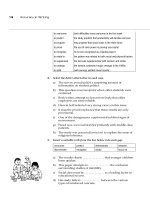Chapter 117. Health Advice for International Travel (Part 4) pptx
Bạn đang xem bản rút gọn của tài liệu. Xem và tải ngay bản đầy đủ của tài liệu tại đây (14.07 KB, 5 trang )
Chapter 117. Health Advice for
International Travel
(Part 4)
Prevention of Gastrointestinal Illness
Diarrhea, the leading cause of illness in travelers (Chap. 122), is usually a
short-lived, self-limited condition; however, 40% of affected individuals need to
alter their scheduled activities, and another 20% are confined to bed. The most
important determinant of risk is the destination. Incidence rates per 2-week stay
have been reported to be as low as 8% in industrialized countries and as high as
55% in parts of Africa, Central and South America, and Southeast Asia. Infants
and young adults are at particularly high risk. A recent review suggested that there
is little correlation between dietary indiscretions and the occurrence of travelers'
diarrhea. Earlier studies of U.S. students in Mexico showed that eating meals in
restaurants and cafeterias or consuming food from street vendors was associated
with increased risk.
Etiology
(See also Table 122-3) The most frequently identified pathogens causing
travelers' diarrhea are toxigenic Escherichia coli and enteroaggregative E. coli
(Chap. 143), although in some parts of the world (notably northern Africa and
Southeast Asia) Campylobacter infections (Chap. 148) appear to predominate.
Other common causative organisms include Salmonella (Chap. 146), Shigella
(Chap. 147), rotavirus (Chap. 183), and norovirus (Chap. 183). The latter virus has
caused numerous outbreaks on cruise ships. Except for giardiasis (Chap. 208),
parasitic infections are uncommon causes of travelers' diarrhea. A growing
problem for travelers is the development of antibiotic resistance among many
bacterial pathogens. Examples include strains of Campylobacter resistant to
quinolones and strains of E. coli, Shigella, and Salmonella resistant to
trimethoprim-sulfamethoxazole.
Precautions
Although the mainstay of prevention of travelers' diarrhea involves food
and water precautions, the literature has repeatedly documented dietary
indiscretions by 98% of travelers within the first 72 h after arrival at their
destination. The maxim "Boil it, cook it, peel it, or forget it!" is easy to remember
but apparently difficult to follow. General food and water precautions include
eating foods piping hot; avoiding foods that are raw, poorly cooked, or sold by
street vendors; and drinking only boiled or commercially bottled beverages,
particularly those that are carbonated. Heating kills diarrhea-causing organisms,
whereas freezing does not; therefore, ice cubes made from unpurified water should
be avoided.
Self-Treatment
(See also Table 122-5) As travelers' diarrhea often occurs despite rigorous
food and water precautions, travelers should carry medications for self-treatment.
An antibiotic is useful in reducing the frequency of bowel movements and
duration of illness in moderate to severe diarrhea. The standard regimen is a 3-day
course of a quinolone taken twice daily (or, in the case of some newer
formulations, once daily). However, studies have shown that a single double dose
of a quinolone may be equally effective. For diarrhea acquired in areas such as
Thailand, where >90% of Campylobacter infections are quinolone resistant,
azithromycin may be a better alternative. Rifaximin, a poorly absorbed rifampin
derivative, is highly effective against noninvasive bacterial pathogens such as
toxigenic and enteroaggregative E. coli.
The current approach to self-treatment of travelers' diarrhea is for the
traveler to carry three once-daily doses of an antibiotic and to use as many doses
as necessary to resolve the illness. If neither high fever nor blood in the stool
accompanies the diarrhea, loperamide may be taken in combination with the
antibiotic.
Prophylaxis
Prophylaxis of travelers' diarrhea with bismuth subsalicylate is widely used
but only ~60% effective. For certain individuals (e.g., athletes, persons with a
repeated history of travelers' diarrhea, and persons with chronic diseases), a single
daily dose of a quinolone or azithromycin or a once-daily rifaximin regimen
during travel of <1 month's duration is 75–90% efficacious in preventing travelers'
diarrhea.
Illness after Return
Although extremely common, acute travelers' diarrhea is usually self-
limited or amenable to antibiotic therapy. Persistent bowel problems after the
traveler returns home have a less well-defined etiology and may require medical
attention from a specialist. Infectious agents (e.g., Giardia lamblia, Cyclospora
cayetanensis, Entamoeba histolytica) appear to be responsible for only a small
proportion of cases with persistent bowel symptoms. By far the most frequent
causes of persistent diarrhea after travel are postinfectious sequelae such as lactose
intolerance or irritable bowel syndrome. A recent meta-analysis showed that
postinfectious irritable bowel syndrome may occur in as many as 4–13% of cases.
When no infectious etiology can be identified, a trial of metronidazole therapy for
presumed giardiasis, a strict lactose-free diet for 1 week, or a several-week trial of
high-dose hydrophilic mucilloid (plus lactulose for persons with constipation)
relieves the symptoms of many patients.









